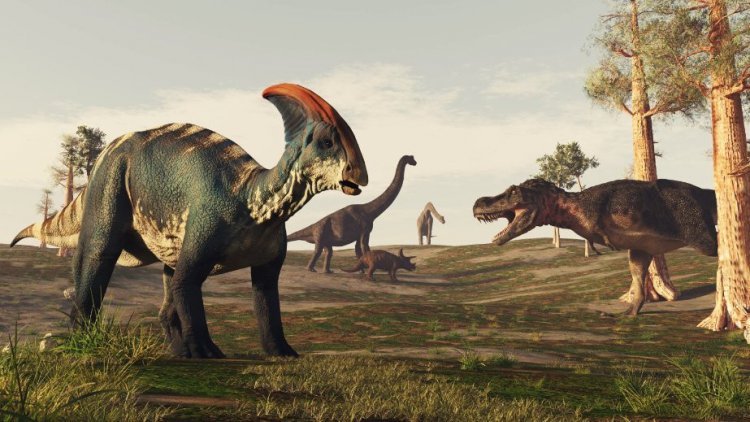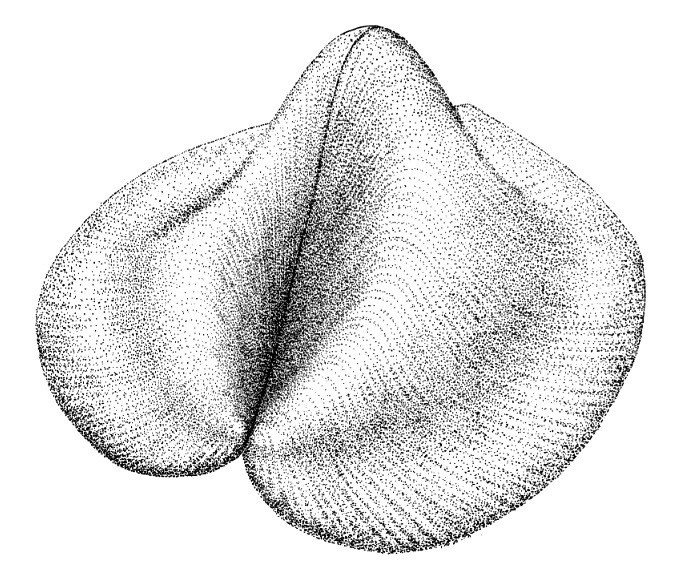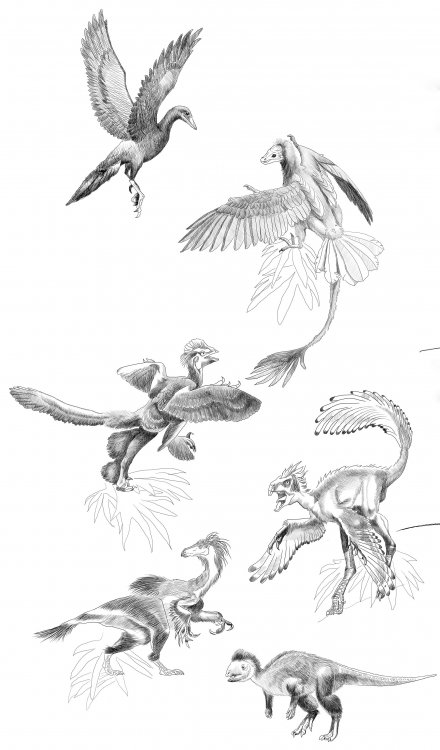Andrey Yuryevich Zhuravlev. Photo source: Elena Librick / Scientific Russia
The history of Earth comprises five major mass extinctions of animals. What reasons provoked them, and how did life on the planet develop afterwards? Is it true we are now witnessing the sixth mass extinction? How do global glaciations relate to the increase in Earth’s biodiversity? Andrey Yuryevich Zhuravlev, Doctor of Biological Sciences, Professor of the Department of Biological Evolution, Faculty of Biology, Lomonosov Moscow State University (MSU), and science communicator answers these and other questions.
― There are five major mass extinctions in the history of Earth. Please tell us about them.
― They are called major because more than half and, in some cases, 75% of all animal species that lived on land and in the ocean at that time would die out. Of course, the Permian-Triassic Extinction is considered to be the most severe extinction event. It happened about 250 million years ago. This catastrophe formed the boundary between the Paleozoic and Mesozoic eras. At that time, about 90% of animal species disappeared. The second most important extinction took place at the boundary of the Cretaceous and Paleogene periods, that is, the Mesozoic and Cenozoic eras (about 66 million years ago).
― Did dinosaurs become extinct at that time?
― Yes, they did. The Cretaceous-Paleogene extinction event ended the Mesozoic era and led to the extinction of approximately 75% of animal species, including not only dinosaurs but also flying lizards, giant sea reptiles, ammonites, and other marine and terrestrial animals. In addition, there are three other less significant mass extinctions. One of them occurred at the boundary of the Triassic and Jurassic periods (about 200 million years ago), the second one ― at the end of the Ordovician period (at the beginning of the Paleozoic era, about 445 million years ago), and the third one ― towards the end of the Devonian period (about 370 million years ago).
In fact, there are many more than five major extinctions in the history of the Earth. There is such a paleontological concept as background extinction: broadly speaking, some species constantly die out. However, there are also peak extinctions that are usually caused by some external factors and lead to more intense extinction per unit time (from tens of thousands to millions of years). From our perspective, mass extinction is a process where the number of species that die out prevails over that of new species. The significance and rate of extinction depend on how stable the biological system is at a given time. For example, the biota actually changed after every sneeze in the Cambrian (539–485 million years ago) or Ediacaran (635–539 million years ago) periods! Major extinctions became a significantly less common phenomenon later on.
Timeline of mass extinctions in the history of the Earth
― Late Ordovician Extinction, 445 million years ago. Earth glaciation and extinction of multiple groups of warm water echinoderms, sponges, corals, trilobites, graptolites, and conodontophorids.
― Frasnian-Famennian Extinction, 372 million years ago. Multiples species of agnathans and fish as well as sponges, brachiopods, and ammonites.
― Permian-Triassic Extinction, 252 million years ago. Colossal change in marine biota, extinction of large-size fusuline foraminifera, trilobites, Paleozoic corals, multiple brachiopods, ammonites, sea lilies, etc.
― End-Triassic Extinction, 201 million years ago. The disappearance of species surviving the extinction at the boundary of the Paleozoic and Mesozoic eras (e.g., conodontophorids).
― Cretaceous–Paleogene Extinction, 66 million years ago. Extinction of dinosaurs, pterosaurs, plesiosaurs, mosasaurs, ammonites, giant bivalves — rudists, etc.
Photo source: auntspray / 123RF
The best-known extinction events are the Permian-Triassic (End-Permian) Extinction and Cretaceous–Paleogene (End-Mesozoic) Extinction, in the course of which 75% - 90% of animal species died out. Such mass extinction events renewed the biota and altered general organic evolution patterns.
Photo source: allvision / 123RF
― Paleobotanic eras and animal eras are offset from each other by about 40 million years. Is it true that mass plant extinction occurred on the planet several tens of millions of years before the extinction of dinosaurs?
― Indeed, the evolution of plants is slightly ahead of the animal world. Therefore, for example, the Cenophytic came before the Cenozoic. It means that the “paradigm shift” in the plant kingdom (including the emergence of new plants) was completed earlier than it happened in the animal world. A renewal took place on land, among the plants, already in the middle of the Cretaceous period. In fact, the same is observed for the Mesophytic and Mesozoic: the Mesozoic was preceded by the Mesophytic.
The Cenophytic is the era of the Earth’s vegetation cover evolution superseding the Mesophytic. It begins in the Late Cretaceous and continues to this day. It is characterized by the dominance of flowering plants and approximately coincides with the dominance of mammals in terrestrial faunas.
The Cenozoic is the Earth’s current geological era representing the last 66 million years. The lower boundary of the Cenozoic erathem was established by the emergence of new forms of marine algal plankton. The name is translated from Greek as “new life” (καινός = new + ζωή = life).
Plants representing the modern world (more than 80% of them are flowering plants) occupied an important place in the terrestrial ecosystem in the second half of the Cretaceous having quickly replaced more ancient forms. Some of the former dominants became relics, for example, the well-known ginkgo. Now it is a single species. However, there were many different ginkgo species in the Cretaceous. Some groups completely disappeared, for example, Cheirolepidiaceae. The latter produced the resin, in which we find various Cretaceous fossils including the fragments of dinosaurs and ancient birds. Throughout the Late Cretaceous, flowering plants progressively and continuously forced their competitors out. By the end of the Mesozoic era, the plants were already strongly similar to those we have today. By the way, the ecosystem itself was quite stable at that time. It was not that stable by the end of the Paleozoic era; that’s why about 90% of animal species disappeared during the Permian-Triassic Extinction. At the end of the Cretaceous period, no more than 75% of species became extinct despite the multiple cataclysms.
― Which of the dinosaur extinction hypotheses do you consider the most plausible?
― Perhaps, a broad range of reasons played a role in this case. Scientists find new information regarding the Cretaceous-Paleogene extinction event every year. For example, a recent article has shown that the famous Chicxulub meteorite that fell into the Caribbean Sea about 66 million years ago probably fell apart when approaching the Earth. One of its fragments has been found recently in the ocean off the coast of Guinea in Western Africa at a depth of about 200 meters. There may be other fragments that have not been discovered yet. When this meteorite fell, West Africa was about three thousand kilometers closer to current South America, so it is not surprising that the fragments were found in this place. In general, this impact from space caused rapid temperature fluctuations on Earth and several other catastrophic phenomena.
― After all, large meteorites had fallen before. Why didn’t they destroy animals during the previous events?
― It is true. However, once again, the consequences of their falls are related to the state of the biota at that moment. Speaking about dinosaurs, they probably were not at the top of their form. Mammals were already significantly more diverse than reptiles by that time: just like flowering plants among gymnosperm forests, they gradually occupied more and more ecological niches. The rise of mammals occurred at the beginning of the Cenozoic era, and it continues to this day.
An external impact on an unstable biota is fundamentally different from an impact on a stable biota, as the latter recovers at a significantly higher rate. Therefore, after the Permian-Triassic Extinction which was most likely caused by Siberian trap volcanism, the world recovered for five million years ― it is a huge period! It took only 100 thousand years for the world to recover after the Cretaceous-Paleogene extinction event. And these estimates are even exaggerated. Many groups of organisms, even plankton, recovered in the meteorite impact area in the first thousand years. Phytoplankton regenerated, and it is the basis of all life not only in the ocean but also on land. Forests grew anew, the rapid evolution of mammals began, and they quickly reached large dimensions.
― What effect do mass extinctions have on animals’ phenotype? For instance, do they get smaller?
― It is hard to say that relatively to mammals, as teeth are often the only element that we have for such verification. In this case, they are not very informative especially if it is unknown to which group this animal belonged. As for mollusks and other marine animals, fortunately, we have a more detailed paleontological record, and it is clear that they become smaller. In paleontology, there is even such a concept as the Lilliput effect when we see that large ancestors are substituted with significantly smaller descendants.
Permian-Triassic Extinction, 252 million years ago. A global event occurred at the boundary between the Permian and Triassic periods — an areal eruption of basalt (trap) volcanoes in eastern and partly western Siberia as well as in Taimyr and within the current water area of the Kara Sea. The process could last from 10 to 800 thousand years. The eruption covered 5–7 million km2 of land and threw out from two to three million km3 of volcanic materials from the deep interior of Earth, including from 30 to 170 thousand gigatonnes of carbon dioxide. In Eastern Siberia, the lava sheet reached a thickness of 1.8 km in some places.
Photo source: fominayaphoto / 123RF
― What exactly is the reason for such a decrease in size?
― As a rule, during major extinctions, primary producers (organisms that produce organic compounds using solar energy) are the first to die out, and there is nothing to eat in this case. The chemical composition of the ocean frequently changes, and it can become very unfavorable for the construction of shells and other skeletons. As a rule, shells are calcareous, and internal skeletons are phosphate. Despite this fact, certain elements are still required to create them. However, you cannot build a large and good skeleton under the conditions of high water acidity and low oxygen content, as it dissolves faster than it is built. It becomes difficult for them to live under such conditions.
Giant Triassic bivalve Wallowaconcha from North America (drawing by Roxanne Jumer for T. Yancey, G. Stanley, Jr., 1999. Giant Alatoform Bivalves in the Upper Triassic of Western North America)
The listed range of factors works towards dwarfing, that is, in Jonathan Swift’s terms, the period of midgets begins after a mass extinction. However, it is often followed by the rise of very large organisms, as there is a lot of free space, and those who used to be small get larger. For example, after the Permian-Triassic extinction, the seas were full of bivalves of extraordinary dimensions, one meter in diameter, and even more! They looked like sombrero hats. The entire bottom of a coastal lagoon could be covered with these large creatures, and it is quite surprising considering that their ancestors were smaller than a palm. Approximately the same happened to mammals after the Cretaceous-Paleogene Extinction: previously, dinosaurs did not let mammals make it into a large-sized category. However, when they were gone, mammals immediately became larger.
Dinosaurs are going to take off (from bottom to top): Kulindadromeus, Beipiaosaurus, Similicaudipteryx, Anchiornis, Jeholornis, Yanornis (drawing by Alina Konovalenko for A. Zhuravlev, 2016, Flying Giraffes…).
― On the contrary, the remaining dinosaurs decreased in size and turned into birds, right?
― Birds can be called the descendants of dinosaurs. We can see that dinosaurs became more and more like birds throughout their history, down to the smallest physiological features. They are similar in behavior. Recent examinations, including computed tomography, show that dinosaur eggs were brightly colored, and it is always a sign of complex behavior. In addition, dinosaurs that hatched eggs have been discovered! It turned out that these eggs were of different temperatures: we see the same thing in modern birds. It is good for birds if chicks hatch gradually rather than all at once, as it is easier to feed them this way.
To sum up, many dinosaurs died out, while many of them survived as birds. Again, it was conditional on the relative stability of the ecosystem. It was not possible to eliminate all of them. The extinction affected the species that already were on the decline of their development at that moment.
― Animals did not become extinct at once, right? How long could this process take?
― Apparently, dinosaurs died out more or less simultaneously all across the western part of North America. All the most detailed sedimentary deposits capturing the circumstances of their extinction are located there. You see for yourself how large dinosaurs disappear and, then, it is barren rock. This layer is no more than several centimeters thick but thousands of years are literally compressed in it. After that, it took time for ferns, mushrooms, and forests to emerge in this region.
Speaking about the planet as a whole, some species could linger for a while in certain areas, and some of them were not affected by the extinction at all. There were so-called refuges or shelters where some animals, primarily small ones, could survive this adverse period. Such zones were probably located in Australia, Siberia, and Antarctica which was still quite warm at that time. The same thing happened in the sea. Some species were affected by the extinction more heavily, while others were left almost intact.
As for the duration of the extinction event, its final stage lasted for a period of hundreds or thousands of years. However, this stage was preceded by several million years when the diversity and abundance of some groups of organisms began to decline. For the western part of North America, it is estimated that edmontosaurs (comb-crested dinosaurs with strong teeth to grind plant fibers) became dominant among large herbivorous dinosaurs at the very end of the Late Cretaceous. They practically substituted horned dinosaurs and long-necked sauropods but the terrestrial biota became more monotonous and vulnerable.
― They say marine life is most affected by extinctions. Why is that?
― On the one hand, marine life statistics are easier to capture, and we simply have more information in this field. On the other hand, our atmosphere, including its gas balance, recovers significantly more quickly than the hydrosphere. If the oxygen level decreases, the ocean needs several thousand years to re-oxygenate or recover from excess carbon dioxide that, as I have already said, considerably acidifies water and has a negative impact on skeletal mineralization in organisms. The lack of oxygen in water also has negative effects: the skeletal organic collagen matrix is difficult to create without a sufficiently high oxygen level. In the meantime, marine organisms are more isolated, including from ultraviolet radiation, and large volcanic eruptions or asteroid explosions destroying the ozone layer are less catastrophic for them. Therefore, the idea of more severe extinctions in the ocean is an illusion.
― What is your opinion about the Snowball Earth hypothesis? This hypothesis proposes that, about 700 million years ago, our planet became completely covered with ice, which led to the extinction of multiple unicellular organisms and the ultimate formation of multicellular life when the “snowball” defrosted.
― Such an event as Snowball Earth has undoubtedly occurred in the history of our planet, and more than once. It is no coincidence that the entire period in the history of Earth is called the Cryogenian (from the Ancient Greek words “cold” and “birth”). Recently, I have occasionally traveled to Mongolia, where the very glacial deposits of the cryogenic period that began about 720 million years ago and ended about 635 million years ago come to the surface. They are thin clays with random piles of pebbles and boulders once melted out of floating glaciers that descended from land and carried away pieces of rock.
During this period, the Earth encountered three major glaciations each of which lasted for several million years.
The entire globe was covered with snow and ice. The Rodinia supercontinent (by the way, from the Russian word “rodina” meaning “motherland,” as it seemed to give birth to other continents) was located at the equator, and one would think that no glaciation could take place there. In fact, it is this position of the supercontinent that triggered global glaciation. At that time, the continent was completely “bald,” i.e., without any vegetation. Its albedo (reflectivity) was very high: Earth’s surface used to reflect solar heat, and the continent was getting increasingly colder until it finally began to freeze. This is the so-called positive response between glaciation and an increase in the planet’s albedo. Today we find deposits of those ancient glaciers across the globe. However, these large glaciers accumulated a lot of small clay particles containing such elements as iron and potassium necessary for the development of phytoplankton. For this reason, their active melting led to the rapid growth of these organisms and a rapid substitution of one life form with another. Ultimately, the world of bacteria and archaea (prokaryotes) was replaced with the world of genuine cellular organisms (eukaryotes).
Most likely, the Earth’s complete glaciation had a positive effect on organisms and led to the rise of multicellular life. Judging by biomarkers, before this glaciation, the world was inhabited mainly by bacterial communities. The biomarkers of multicellular organisms, that is, plants, fungi, and animals, began to predominate after the glaciation.
― Is it true that the greatest biodiversity in the entire history of Earth occurred during the last ice age which ended 11.7 thousand years ago, that is, in the days of mammoths and hairy rhinos?
― Yes, it is. A huge variety of animals and their gigantic biomass are associated with this period. Among other things, it is confirmed by the innumerable discovered remains of mammoths and other animals of that time. Mammoth tusks alone are collected in the amount of about 40 tons a year in Russia, mainly in Yakutia (starting from the late 17th century when they began to keep records)! Tropical and subtropical regions, that is, Africa, Australia, and South America, were also characterized by a gigantic rise in biodiversity at that time. What is more, this diversity was unique in each region.
The last ice age ended 11.7 thousand years ago. By that time, the megafauna of Australia almost disappeared, and there were significantly fewer animals in the North and South Americas. Only northeastern Siberia was still sufficiently populated until the last moment.
― What caused such a diversity of life during the ice age?
― At that time, the Earth was very different from what we see today. Now a huge part of the planet is covered with forests. However, during that period, steppes dominated the Earth, including savannahs, pampas, and prairies. There were almost no forests. It is commonly known that the steppe biota is very productive, as grasses mature twice a year and regenerate very quickly. Has everything been eaten? Not a big deal: in six months, there’s a harvest of either winter or spring crops again. Even now we practice farming according to the steppe calendar still eating what the nature of that time created. The most fertile soils, including black soil, are the products of the same steppe biota, the steppe biome, as well as the highly productive cereals that make our basic diet.
― After all, it is surprising that the biodiversity of mammals reached its zenith under these unfavorable conditions when there was glaciation around.
― Indeed, giant ice sheets covered almost all of North America, Europe, and part of Asia. The entire Antarctica was under an ice shell at that time. It would seem that the conditions were just terrible. And meanwhile, this was probably the most productive biota in the entire history of our planet flourishing on Earth at that time! In addition, it was the most diverse if we take large-sized animals that existed in vast numbers: in Yakutia or Chukotka, there was at least one species of mammoth, two or three species of rhinos, and so on. Notably, more and more finds of that ancient megafauna are discovered every year: giant herds of wild horses and saigas, muskoxen, bison (several species as well) that were hunted by huge cave lions, and many more.
On the contrary, in some sense, animals’ life used to be easier life under the harsh conditions of the ice age, as in summer they were not overwhelmed by mosquitoes and midges representing a curse to modern fauna. For example, horses become emaciated in the shortest time because of blood-sucking insects and gain weight only by winter. Experienced Siberian cattle breeders claim that sometimes even herds of horses and reindeer die out, as midges clog their respiratory passages.
Woolly mammoths of Yakutia (drawing by Alina Konovalenko for A. Zhuravlev, Law of the Russian Federation on Fostering “Tomb Raiders”).
― Is it fair to say that we are witnessing the sixth extinction triggered by human activity?
― Unfortunately, it is true, as every year we register the extinction of some large animal. For example, this year, the Psephurus or Chinese paddlefish, one of the largest and most peculiar freshwater fish in the world, has been finally declared extinct. The final disappearance of the Psephurus is probably associated with the construction of the Three Gorges Dam, a cascade of powerful hydroelectric power plants, on the Yangtze River in China. In addition, recently it has been reported that the Chinese river dolphin also became extinct. Every year, we register the disappearance of one or another animal, and some of them, such as the Psephurus or Chinese river dolphin, are so large, which makes it impossible not to notice their absence.
― After all, are we talking about a background extinction event or a peak one, that is, a great extinction?
― Fortunately, we have not reached a real great extinction yet. However, given the explosive growth of the population, especially in countries rich in fauna, the disappearance of animals goes on at an alarming rate. Moreover, there are still a lot of undescribed species that we may also lose without even knowing it.
A massive collection of insects assembled by scientists in the conservation areas of Costa Rica came as a surprise for me personally. A constant record of living creatures has been kept for several decades on tropical Barro Colorado Island. Researchers install special light traps to gather all insects. The number of these insects has become significantly smaller in recent years. It applies to not only their quantity but also the diversity of species ― it has fallen substantially. Unfortunately, such processes take place on our planet. They are generally difficult to register, as there are very few sites like Costa Rica where such studies are conducted with all due care and regular records. It is very difficult to calculate globally how quickly and at what rate species and their habitats disappear.
― Dr. Zhuravlev, let’s end our conversation on a positive note. Please tell us about your book Adventures of Species: Vampiropods, Spidertails and Other Transitional Forms in Animal Evolution published this year by Alpina Non-Fiction.
― The optimistic aspect is that not all animals died out even in the most difficult time, for example, at the boundary between the Permian and Triassic periods. The same is relevant to the Cretaceous-Paleogene Extinction and other catastrophic events. In my opinion, these ancient events were worse than the current invasion of mankind on the planet. What is happening now primarily concerns us: we create unfavorable conditions for our existence. Other species are less affected. If unfortunately for us, humanity dies out, the planet will recover literally in decades. Probably, there will be no such biodiversity at first, but a new biota will gradually acquire original features. Of course, it is difficult to predict what the planet will look like under such conditions.
As for the book, it is about the continuous history of Earth’s living organisms: from the emergence of unicellular and multicellular life to the formation of the existing variety of animals. The world is unpredictable, and it is hard to imagine how the organisms living next to us will change, even though we know a lot about evolutionary patterns. I have always been amazed at how living organisms manage to occupy niches that seem to be good for nothing.
Andrey Zhuravlev is the winner of the 2021 Russian Academy of Sciences Prize in the category “Best Popular Science Book on Ecology, Environment Protection, and Biodiversity Conservation.”
Photo source: Elena Librick / Scientific Russia
― Could any species occupy our niche? What about chimpanzees?
― I think that no one will occupy our niche, and it is very sad. Several million years and very specific conditions are required for an intelligent being to emerge on the planet. Chimpanzees and bonobos are very smart, but there are too few of them…
― Once there used to be few of us, too.
― It is true, but we used to live in different settings. Just like all glacial megafauna, we are a product of the steppe biome. After all, chimpanzees, gorillas, and bonobos are forest creatures meaning that they are fine the way they are, and, in general, they do not need to get any smarter. However, again, these animals are quite intelligent. Recently, I have been reading with great interest the books written by anthropologists who study the habits of chimpanzees and bonobos, and their behavior is remarkably similar to ours. For example, just like people, they tend to show empathy. These apes can understand the feelings of another creature and take pity on it. I believe that sometimes we are even less sympathetic than chimpanzees and bonobos. In addition, they sympathize with not only their relatives but also animals of other species, and sometimes their emotions even make them cry. For example, a chimpanzee can approach a bird and try to help it fly if the bird has fallen. Apes observe everything around them and understand that a bird needs to fly to live.
In summary, I do not believe that someone will take our place in nature — except for some hypothetical aliens, and even then they must somehow get here first.










































